Sheep farming in Uganda has emerged as a lucrative venture, offering promising opportunities for both experienced farmers and newcomers. With its favorable climate and diverse grazing lands, Uganda provides an ideal environment for raising healthy and productive sheep.
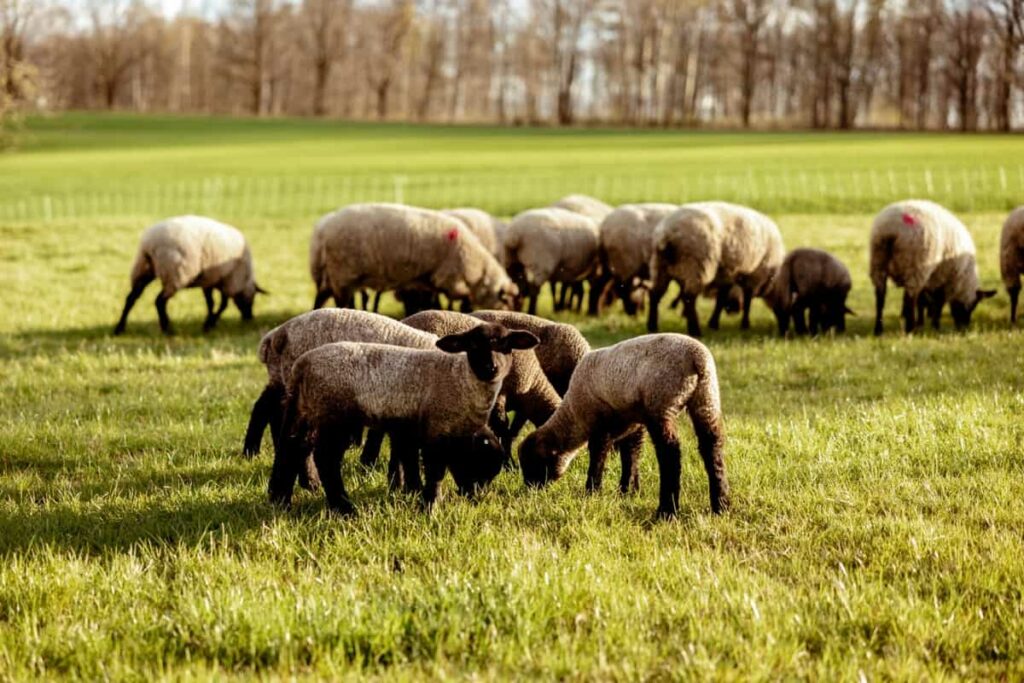
This blog is a comprehensive resource for sheep farming, covering essential aspects such as breeding techniques, nutrition management, healthcare practices, and effective marketing strategies. Whether you’re a beginner starting from scratch or an established farmer seeking to optimize your operations, this guide will equip you with the knowledge needed to succeed.
Sheep Farming in Uganda: A Beginner’s Guide
Sheep farming in Uganda presents a promising opportunity for beginners looking to enter the agricultural sector. With its diverse landscapes, favorable climate, and growing demand for quality meat and wool, Uganda provides an ideal environment for successful sheep farming. Uganda is a landlocked country in East Africa, known for its fertile soils and favorable climate.
Agriculture is a significant sector, employing most of the population and contributing significantly to the country’s GDP. The livestock industry, including sheep farming, plays a vital role in Uganda’s agricultural sector.
Sheep Breeds in Uganda: There are various sheep breeds suitable for farming in Uganda, including the East African Blackhead, the Karamojong, and the Ethiopian hair sheep. Each breed has unique characteristics, such as adaptability to local conditions, disease resistance, and meat or wool production capabilities.
Setting Up Your Sheep Farm: Choose a suitable location with ample grazing land, access to water sources, and appropriate shelter facilities. Construct secure fencing to prevent predators from attacking the sheep. Provide adequate housing for sheep, ensuring proper ventilation, lighting, and cleanliness.
Sheep Nutrition and Feeding: Develop a balanced feeding program that combines pasture grazing, hay, and commercially available sheep feed. Ensure access to clean water at all times, especially during hot weather. Supplement their diet with mineral blocks or mineral-rich feeds to meet their nutritional requirements.
In case you missed it: Karnataka Sheep Farming: A Comprehensive Guide to Loans and Subsidy
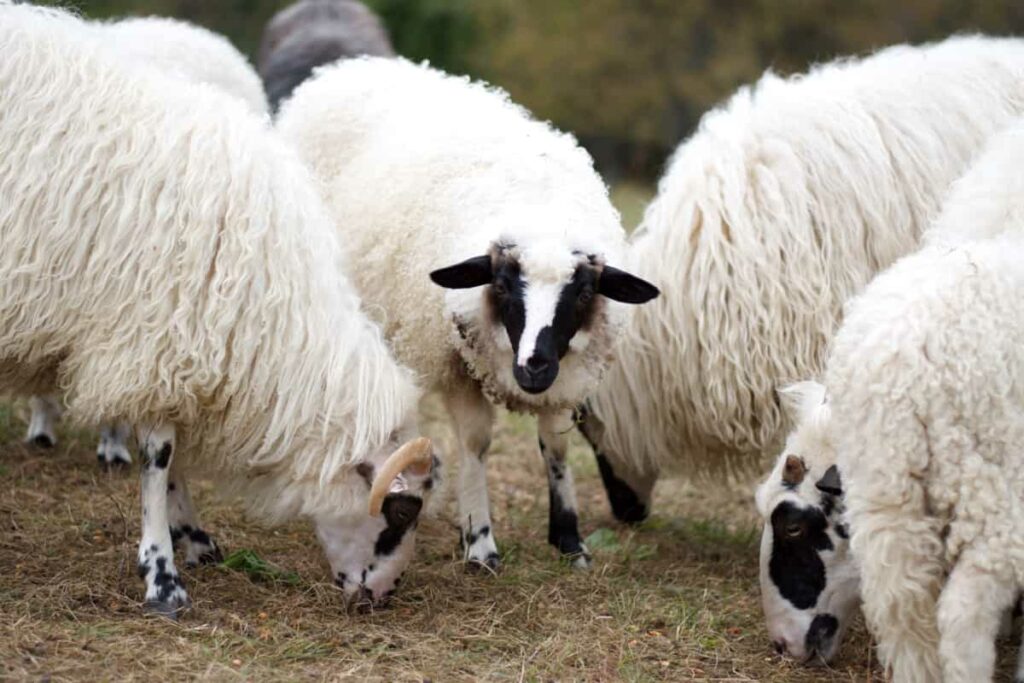
Sheep Health and Care: Regularly monitor the health of your sheep, checking for signs of illness, parasites, or nutritional deficiencies. Consult a veterinarian for vaccinations, deworming, and treatment of common sheep ailments. Maintain good hygiene in the sheep’s living area to prevent the spread of diseases.
Reproduction and Breeding: Understand the breeding cycle of sheep and the best practices for successful mating. Consider crossbreeding to enhance desirable traits in your flock. Provide appropriate care during gestation and lambing, ensuring a safe and healthy environment for newborn lambs.
Best Sheep Breeds for Farming in Uganda
- East African Blackhead: This breed is well-suited to Uganda’s climate and adapted to tropical conditions. Known for its resistance to diseases and high fertility rates, it is an excellent choice for meat production.
- Karamojong: Originating from the Karamoja region, this breed is highly adapted to Uganda’s arid and semi-arid regions. It is known for its hardiness, adaptability to harsh conditions, and excellent meat quality.
- Ethiopian Hair Sheep: This breed thrives in Uganda’s diverse environments. It is prized for its disease resistance, high fertility rates, and good meat quality.
Sheep Farming Techniques and Practices in Uganda
Housing: In sheep farming, providing suitable housing is crucial for the well-being and safety of the animals in Uganda. The sheep’s house should have dry bedding, proper drainage, and sufficient protection from adverse weather conditions and predators. An adult sheep typically requires about 16 to 20 square feet of floor space, while lambing pens should provide 16 to 25 square feet. The roof should be at least 6 feet high, allowing for proper ventilation and ample light. Grazing areas should be enclosed in paddocks to ensure the sheep’s safety. It’s important to have easy access to the house for deliveries and manure handling.
Feeding: To ensure optimal growth, maximum production, and a healthy, disease-free flock, high-quality and nutritious feeds are essential. Sheep generally consume about 3 percent of their body weight in feed daily. While grass and plants are the main food sources, hay can also be included. Feeding should be tailored to meet the specific nutrient requirements, age, weight, and sheep production stage. They need energy, protein, vitamins, minerals, fiber, and water.
Energy deficiency can result in reduced growth, weight loss, low conception rates, smaller wool fiber diameter, and weak spots in the wool. Protein requirements are higher for early-developing lambs to develop their muscles and breastfeeding ewes to give milk. Soybean, cottonseed, sunflower, and legume hays gathered in the early to mid-bloom stages are typical protein supplements.
In case you missed it: Merino Sheep Farming in Kenya: Raising From Scratch for Breeding to Marketing
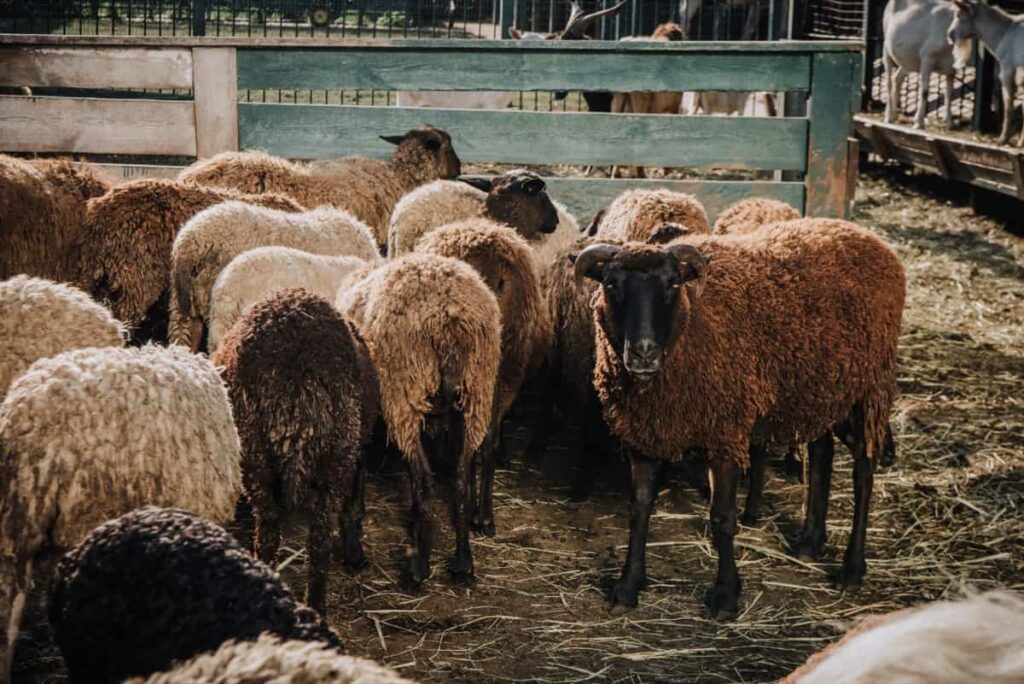
Additionally, trace mixes, or licks containing minerals like phosphorus, magnesium, cobalt, and copper should be added to the feed. Fiber is essential for the rumen’s healthy operation because it promotes salivation and rumination. Additionally, sufficient amounts of clean, fresh water should be offered, especially to breastfeeding ewes.
Breeding: Breeding in sheep farming in Uganda requires Ewe lambs should be bred once they reach puberty, typically between five and 12 months or when they reach 70 percent of their mature weight. On the other hand, Ram lambs can be bred between 5 and 7 months of age at 50 to 60 percent of their mature weight. The size of a ram’s testicles indicates its sperm-producing ability, which usually takes around 49 days to develop fully. Before breeding, ewes should be dewormed, have their hooves trimmed, and be vaccinated if necessary.
For breeding purposes, only sound ewes should be introduced to rams. One ram can be used to breed each group of ewes. It is advised to cull sterile rams and separate older rams from younger ones to reduce fighting. The ideal ram-to-ewe ratio is 1:25 for ram lambs, and for adult rams, it should be 1:35 or higher. Melatonin and prostaglandin are two hormones that may be used artificially to change a ewe’s reproductive cycle. Another way is to introduce a teasing ram to encourage ovulation.
Lambing: During lambing, monitoring and assisting ewes is needed. Overfed ewes can experience difficulties during the lambing process and may require assistance extracting or repositioning the lambs. Ewes should be allowed to lick, clean, and nurse their lambs to ensure they receive colostrum. Identification through ear tagging should be done when the lambs are several weeks old.
At around 10 to 12 weeks, docking, castration (within a week), and vaccination, commonly anti-clostridial, should be performed. Each year, approximately three weeks before lambing, ewes should be revaccinated to ensure high antibody concentrations in colostrum during the first few hours after lambing.
Disease Control: Maintaining a disease-free environment is vital in sheep farming. Effective control of external and internal parasites, as well as proper vaccination protocols, is essential. Internal parasites like worms are controlled through oral anti-parasitic anthelmintics or drenches.
External parasites, including lice, nose bots, sheep itch mites, and maggots, can be managed using backliners, sprays, or immersive sheep dips. Crutching involves shearing wool from the sheep’s rump and is a common preventive measure. Vaccinations are crucial to protect against diseases like anthrax and foot and mouth disease.
Starting a Profitable Sheep Farm in Uganda
Starting a profitable sheep farm in Uganda requires careful planning, proper feeding management, and consideration of market demand. With the right breed selection, sustainable practices, and effective marketing strategies, sheep farming can be a lucrative and rewarding agricultural enterprise in Uganda.
In case you missed it: Dairy Sheep Farming: Raising from Scratch for Breeding to Marketing
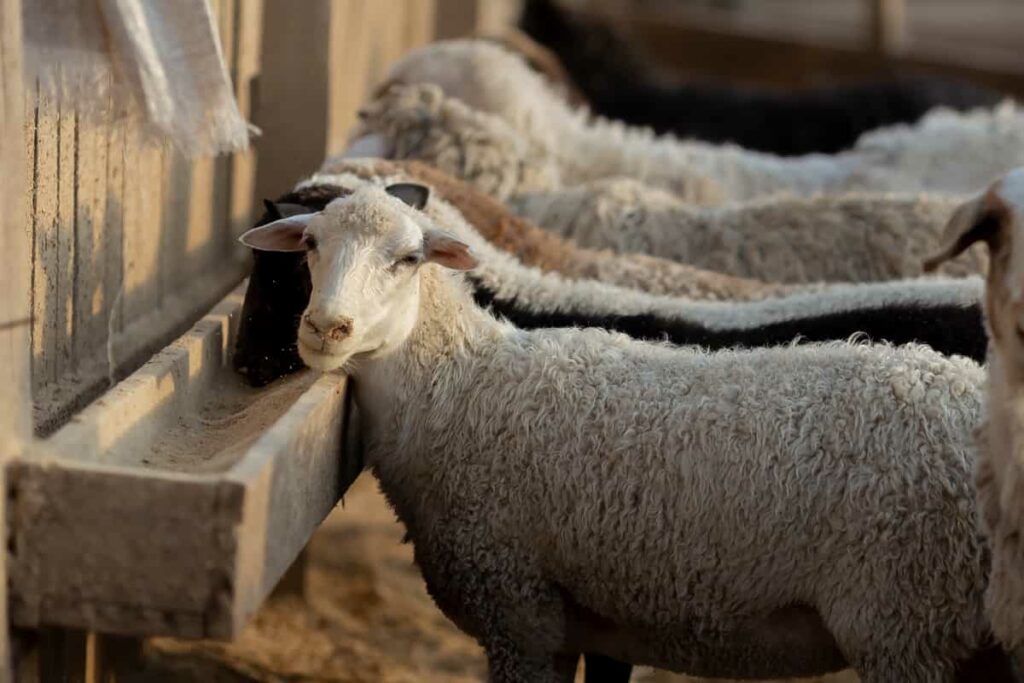
Profitability: Sheep farming can be a valuable source of income for livestock farmers in Uganda. If properly managed, commercial sheep farming can yield quick returns on investment. However, profitability depends on factors such as the type of sheep breed, climate conditions, and market demand.
Zero Grazing: Zero-grazing sheep farming is gaining popularity in Uganda. This approach involves constantly moving the sheep to prevent overgrazing and the conversion of grasslands into pasture. It is a sustainable and cost-effective method that improves soil quality, increases production levels, and reduces greenhouse gas emissions.
Benefits: Sheep farming offers different benefits, including the production of lamb, which can be sold fresh or frozen. Sheep also provide wool, which can be utilized for additional income streams such as wool production. Additionally, sheep manure can be used as fertilizer for crops, promoting sustainable farming practices.
Advantages of Sheep Farming in Uganda
- Suitable Climate: Uganda’s climate is conducive to sheep farming, with moderate temperatures and favorable rainfall patterns that support the growth of nutritious grazing pastures.
- Diverse Landscapes: The country offers a variety of landscapes, including grasslands, hills, and mountains, providing ample grazing areas for sheep.
- Profitability: Sheep farming can be a profitable venture in Uganda, with potential income from the sale of meat, wool, and other by-products like milk and manure.
- Disease Resistance: Many sheep breeds in Uganda exhibit resistance to common diseases and parasites, reducing the risk of health issues and minimizing the need for extensive medical interventions.
- Sustainable Farming: Sheep farming promotes sustainable agriculture as they help manage grasslands, improve soil fertility through grazing, and contribute to crop production through their manure.
- Livelihood Improvement: Engaging in sheep farming can enhance farmers’ livelihoods, offering opportunities for income generation, employment, and poverty alleviation, particularly in rural areas.
- Market Demand: A growing domestic and regional demand for sheep products in Uganda, including meat and wool, presents potential market opportunities for farmers.
- Low Initial Investment: Starting a sheep farm can be relatively affordable compared to other livestock ventures, making it accessible for aspiring farmers with limited resources.
- Easy Management: Sheep are generally docile animals and require less labor-intensive management than larger livestock, making them suitable for small-scale and beginner farmers.
Sheep Nutrition and Feeding Tips in Uganda
Proper nutrition and feeding are essential for the health and productivity of sheep in Uganda. Farmers should utilize abundant grazing resources to ensure optimal health, supplement their diet with high-quality feeds like silage, hay, and crop residues, and maintain a balanced diet with carbohydrates, proteins, fats, vitamins, and minerals. Ensure a constant and clean water supply and mineral supplements to prevent deficiencies and promote optimal health.
Adjust the feeding program based on seasonal variations in forage availability and nutritional content, and divide the flock into smaller groups based on age, size, and nutritional requirements. Regularly monitor body condition scores and adjust feeding to prevent overfeeding or underfeeding. Consult a veterinarian or livestock expert for guidance on nutritional requirements, feed formulations, and management practices specific to Uganda.
In case you missed it: The Ultimate Guide to Sheep Vaccination Schedule: Deworming Chart/Calendar
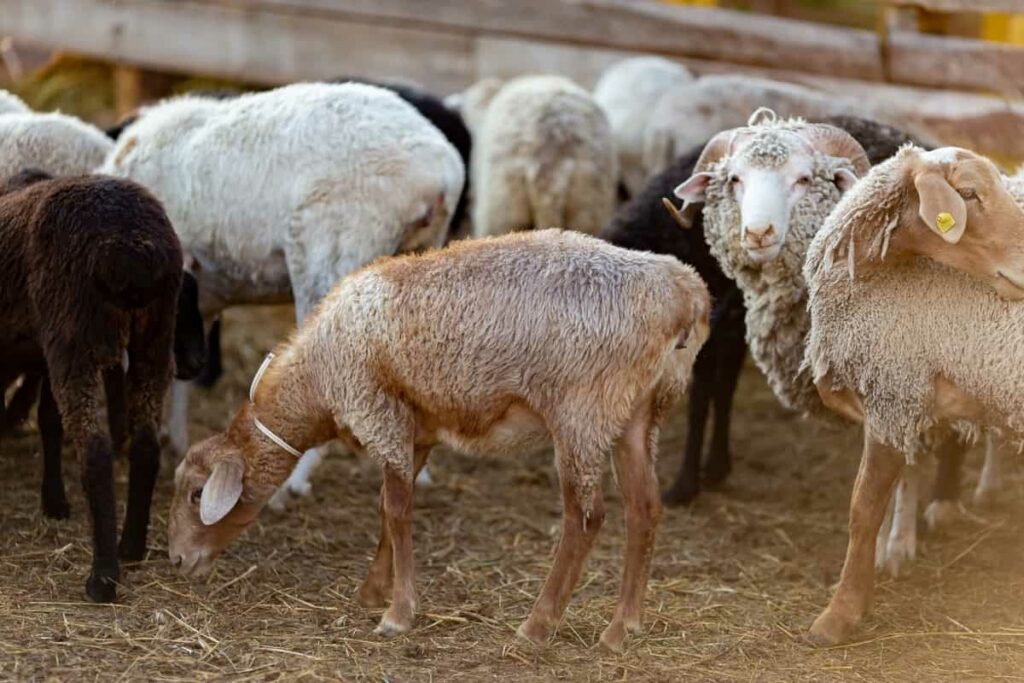
Common Diseases in Sheep Farming in Uganda and Prevention
Sheep farming in Uganda is susceptible to various diseases, including pneumonia, foot rot, gastrointestinal parasites, enterotoxemia, orf, tick-borne diseases, ketosis, and brucellosis. Farmers must be aware of these diseases and take preventive measures to maintain a healthy flock. Common diseases include pneumonia, foot rot, gastrointestinal parasites, enterotoxemia, orf, tick-borne diseases, ketosis, and brucellosis.
Farmers should maintain proper ventilation, reduce overcrowding, and maintain good hygiene in their sheep housing to prevent these diseases. Regular inspections and acaricides are essential for controlling ticks and preventing ketosis in pregnant ewes. Lastly, proper nutrition and monitoring pregnant ewes’ body conditions can help prevent ketosis.
Breeding Strategies for Sheep in Uganda
Breeding strategies in Uganda are needed to maximize sheep productivity and quality. Key points include selecting superior breeding stock based on desirable traits, crossbreeding, controlling breeding seasons, maintaining healthy rams, using artificial insemination, keeping accurate records, evaluating breeding soundness, and genetic testing to identify favorable traits and potential genetic disorders. These strategies help optimize lambing, management, and feed for optimal sheep production.
Market Opportunities for Sheep Products in Uganda
Market opportunities for sheep products in Uganda are promising. There is a growing demand for sheep meat, wool, and other by-products such as milk and manure. Local and regional markets offer avenues for selling these products. The increasing population, urbanization, and changing consumer preferences contribute to the market’s potential. By tapping into these opportunities, sheep farmers in Uganda can find profitable markets, generate income, and contribute to the country’s agricultural sector’s growth and development.
Sustainable Practices for Sheep Farming in Uganda
Feeding Management: A balanced diet is essential for the health and well-being of sheep. Feed them silage, fresh vegetables, and fruits, ensuring they receive sufficient minerals and water. Consider the specific nutritional requirements of your sheep based on their size, weight, and local weather conditions.
Small-Scale Farming: Small-scale sheep farming is popular in Uganda due to favorable climatic conditions and a potential market for mutton. Starting a small-scale farm can involve purchasing an existing farm, leasing land, or starting from scratch. It requires careful planning, including location considerations, soil quality, and climate conditions.
Commercial Farming: Commercial sheep farming focuses on high-value products such as wool and milk for cheese production. Flocks can range from 50 to 500 animals per hectare, with an average flock size of around 200 animals. Proper feeding, fencing, and containment practices are crucial in commercial farming to avoid damage to crops and property.
In case you missed it: 500 Sheep Farming Project Report and Bank Loan in India
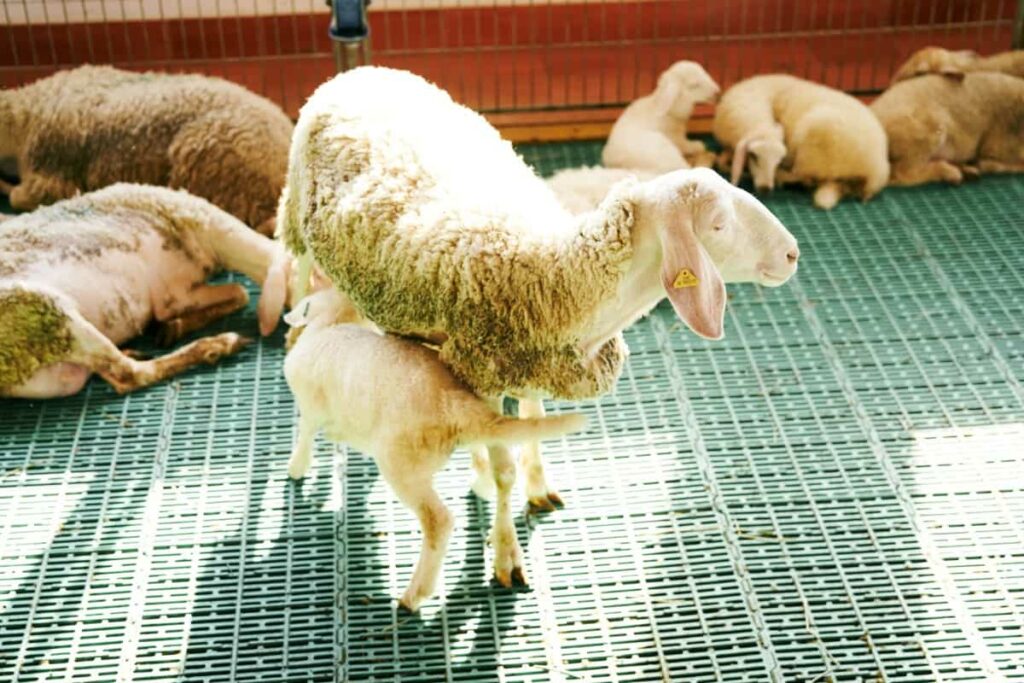
Conclusion
Sheep farming in Uganda offers lucrative prospects, from breeding to marketing. With favorable climatic conditions, diverse landscapes, and growing market demand, aspiring farmers can embark on a successful journey in the dynamic world of sheep farming.
- Irrigation and Water Management in Pineapple Farming
- Blossom to Harvest: Mastering Flowering and Pollination in Papaya Farming
- Pig Fattening Essentials: From Selection to Sale for Beginners
- Raising Wagyu Cattle: A Complete Guide for Premium Beef Production
- Soil Types and Their Water Holding Capacity
- Optimizing Irrigation Schedules for Coconut Groves for Enhanced Yield
- Espresso Your Garden: Coffee Grounds for Healthier Acid-Loving Plants
- The Best Soil Mix for Snake Plants: How to Mix Your Own Snake Plant Soil
- Green Thumb Success: Expert Tips for Cultivating Greenhouse Beans All Year Round
- Bloom All Year Round: The Ultimate Guide to Indoor Hyacinth Care
- Eco-Friendly Gardening: How to Make Liquid Fertilizer from Kitchen Waste
- Ultimate Guide to Grow Anise in Pots: Explore Seed Propagation to Harvesting
- Guide to Raising Chester White Pigs: Discover Breed Facts to Growth Management
- Mastering the Elegance: The Ultimate Guide to Weeping Cherry Tree Care, Planting, and Maintenance
- Ultimate Guide to Planting Garlic in Grow Bags: Growing Strategies for Beginners
- How to Fix Spider Plant Leaf-Related Problems: Natural and Organic Remedies
- 10 Reasons Why Your Tulsi Plant is Shedding Leaves: Home Remedies and Solutions
- Optimizing Growth and Yield: The Advantages of Palm Bunch Ash Fertilizer
- Utilizing Neem Oil Extract as a Natural Pesticide for Hydrangea
- From Soil to Harvest: Various Ways in Which Farmers Can Use AI Tools
- Steps to Encourage and Induce Citrus Flowers: A Comprehensive Guide
- How to Fix Snake Plant Leaf-Related Issues: Natural and Organic Remedies
- Transform Your Garden into a Fragrant Oasis with Raat Ki Rani (Night Blooming Jasmine)
- Discover the Ideal Chicken Breeds for Philippine Farms
- How to Create a Poultry Egg Farm Business Plan for Profits
- Grow Lemon Cucumbers Like a Pro: Insider Techniques for Bountiful Yields
- Ultimate Guide to Caring for Your Pink Princess Philodendron: Tips for Thriving Variegation
- Areca Nut Profit Per Acre: Calculating Yield and Cost of Cultivation
- How Kaveri Chicken is Becoming a More Profitable Breed in Indian Backyards
- Transform Your Barn: 9 Steps to Convert a Horse Stall into a Chicken Coop
- Exploring Suffolk Sheep Disadvantages with Limitations and Challenges
- Guide to Solving Potted Lemon Tree Problems: How to Revive Lemon Tree in Containers
- Steps to Encourage Female Pumpkin Flowers: Best Strategies for More Flowers and High Yields
- Ultimate Guide to Yellow Raspberries: Exploring from Planting to Care
- Ultimate Guide to Planting Ginger in Grow Bags: Growing Strategies for Beginners
- Ultimate Guide to Growing Red Creeping Thyme: Propagation, Planting, Pruning, and Care
